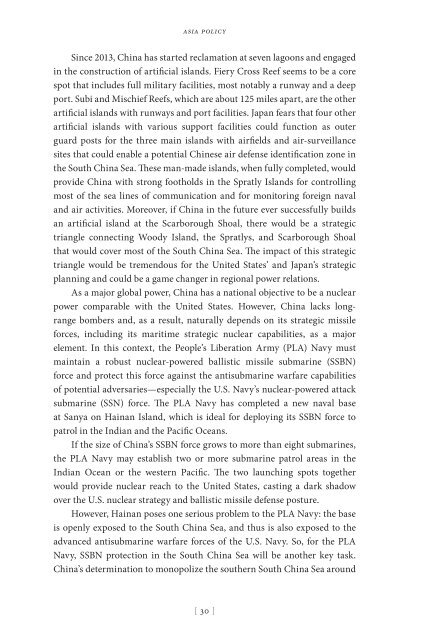You also want an ePaper? Increase the reach of your titles
YUMPU automatically turns print PDFs into web optimized ePapers that Google loves.
asia policy<br />
Since 2013, China has started reclamation at seven lagoons and engaged<br />
in the construction of artificial islands. Fiery Cross Reef seems to be a core<br />
spot that includes full military facilities, most notably a runway and a deep<br />
port. Subi and Mischief Reefs, which are about 125 miles apart, are the other<br />
artificial islands with runways and port facilities. Japan fears that four other<br />
artificial islands with various support facilities could function as outer<br />
guard posts for the three main islands with airfields and air-surveillance<br />
sites that could enable a potential Chinese air defense identification zone in<br />
the South China Sea. These man-made islands, when fully completed, would<br />
provide China with strong footholds in the Spratly Islands for controlling<br />
most of the sea lines of communication and for monitoring foreign naval<br />
and air activities. Moreover, if China in the future ever successfully builds<br />
an artificial island at the Scarborough Shoal, there would be a strategic<br />
triangle connecting Woody Island, the Spratlys, and Scarborough Shoal<br />
that would cover most of the South China Sea. The impact of this strategic<br />
triangle would be tremendous for the United States’ and Japan’s strategic<br />
planning and could be a game changer in regional power relations.<br />
As a major global power, China has a national objective to be a nuclear<br />
power comparable with the United States. However, China lacks longrange<br />
bombers and, as a result, naturally depends on its strategic missile<br />
forces, including its maritime strategic nuclear capabilities, as a major<br />
element. In this context, the People’s Liberation Army (PLA) Navy must<br />
maintain a robust nuclear-powered ballistic missile submarine (SSBN)<br />
force and protect this force against the antisubmarine warfare capabilities<br />
of potential adversaries—especially the U.S. Navy’s nuclear-powered attack<br />
submarine (SSN) force. The PLA Navy has completed a new naval base<br />
at Sanya on Hainan Island, which is ideal for deploying its SSBN force to<br />
patrol in the Indian and the Pacific Oceans.<br />
If the size of China’s SSBN force grows to more than eight submarines,<br />
the PLA Navy may establish two or more submarine patrol areas in the<br />
Indian Ocean or the western Pacific. The two launching spots together<br />
would provide nuclear reach to the United States, casting a dark shadow<br />
over the U.S. nuclear strategy and ballistic missile defense posture.<br />
However, Hainan poses one serious problem to the PLA Navy: the base<br />
is openly exposed to the South China Sea, and thus is also exposed to the<br />
advanced antisubmarine warfare forces of the U.S. Navy. So, for the PLA<br />
Navy, SSBN protection in the South China Sea will be another key task.<br />
China’s determination to monopolize the southern South China Sea around<br />
[ 30 ]


